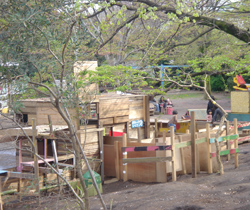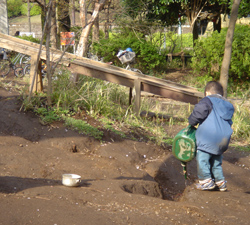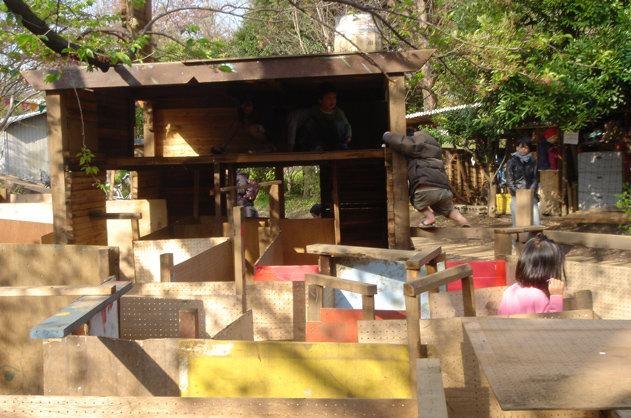Living in one of the world’s largest and most densely populated metropolitan areas, where parks and playgrounds are often sterile, boring or unsafe, many parents may be surprised to learn of local parks that are quite the opposite. At adventure parks, children are free to run around and explore, climb trees, play with water, dig in the mud, and create their own world with nothing but wood, stones, soil and the power of imagination.
Thirty years ago the first adventure or junk playgrounds, here also known as ‘play parks’ or bouken asobiba, were founded in Japan, and they now form an integral part in the lives of many city children. There are over 200 of these playgrounds nationwide, about half of which are located in the Kanto plain.
 The concept of the adventure playground itself originated in the field of landscape planning. Renowned Danish landscape architect C. Th. Sorensen opened the first playground of its kind, a skrammellegpladsen (junk playground) near Copenhagen in 1943 as part of a housing project for disadvantaged families. Sorensen’s aim was “to create a place where children themselves are the creators.” The idea soon became hugely popular, and is still very much in use today. Another well known landscape artist and an advocator of children, Lady Allen of Hurtwood, who visited Sorensen’s park in 1946, is credited with bringing the idea to Britain. From the late 1960s—fueled by a liberal atmosphere and changing attitudes towards child rearing—adventure playgrounds rapidly spread throughout Europe, becoming especially popular in Switzerland and Germany.
The concept of the adventure playground itself originated in the field of landscape planning. Renowned Danish landscape architect C. Th. Sorensen opened the first playground of its kind, a skrammellegpladsen (junk playground) near Copenhagen in 1943 as part of a housing project for disadvantaged families. Sorensen’s aim was “to create a place where children themselves are the creators.” The idea soon became hugely popular, and is still very much in use today. Another well known landscape artist and an advocator of children, Lady Allen of Hurtwood, who visited Sorensen’s park in 1946, is credited with bringing the idea to Britain. From the late 1960s—fueled by a liberal atmosphere and changing attitudes towards child rearing—adventure playgrounds rapidly spread throughout Europe, becoming especially popular in Switzerland and Germany.
Contrary to what parents may expect, less accidents happen on these makeshift playgrounds than on traditional ones.
In Japan, first interest in the topic sparked in the second half of the 1970s, after Lady Allen’s book on adventure playgrounds, Planning for Play, published in 1968, was translated into Japanese. The first permanent adventure playground in Japan—which still exists today—was set up in the year 1979, inside Hanegi Park in Setagaya ward, Tokyo. From the 1990s, almost 20 years later than in Europe and in spite of bureaucratic hurdles, the adventure playground movement became popular throughout Japan. The play parks are now organized as non-profit organizations (NPOs) under the Japan Adventure Playground Organization.
 To this day the concept is roughly the same worldwide: the parks are often set up on wasteland or in a corner of an existing park, and they usually offer different zones, such as a fireplace, a water and sand/mud area, a wood-working area, and an area with makeshift play equipment, like tree huts and swings.
To this day the concept is roughly the same worldwide: the parks are often set up on wasteland or in a corner of an existing park, and they usually offer different zones, such as a fireplace, a water and sand/mud area, a wood-working area, and an area with makeshift play equipment, like tree huts and swings.
The playgrounds are supervised by youth workers, called ‘play leaders’ in Japan. This is sometimes seen as a contradiction to the original idea of letting children play freely and unsupervised, but in most countries the presence of a youth worker is required in order to be able to offer play equipment that does not comply with the playground equipment standard.
Parenting Tip:
* For a list of some popular adventure parks in the Tokyo area, go to www.weekenderjapan.com and click on Lifestyle, then Families.
* Entry to all adventure playgrounds is free and everyone is welcome to play. Check the opening days and hours for each park, as some are only open a few days per week.
* Be prepared for your kids to get very dirty. Old shoes or rubber boots are best, and bring a spare set of clothes and a towel. Do not forget the mosquito repellent. Invite another parent to come along, as it is much more fun in a group. This type of park will usually be most popular with children between 5 and 12 years of age.
* Adventure playgrounds try to enforce a few easy-to-understand rules, and it is best to directly address the play leader when you are not sure how things work. For example, wood working tools or paint may be given out to one child at a time by the play leader, and the child will be expected to return the complete set once he is finished with it. Such rules vary from park to park.
* For more information (in Japanese only),
The play leader’s job is not to tell the children what to do, but to ensure that basic safety rules are observed, to hand out tools and paint, and to organize the numerous activities that are offered year-round, such as harvesting of bamboo sprouts, cooking over an open fire, handcrafting, or making mochi. In many play parks the children can also grow vegetables and flowers.
Contrary to what parents may expect, less accidents happen on these makeshift playgrounds than on traditional ones, where the intended use of the always static equipment is often disregarded
and children pay less attention to what they are doing. On an adventure playground children feel more involved, and thus much more responsible.
An important attraction of adventure playgrounds lie in their everchanging layout, which makes them a place for kids to be carefree and creative. They exceed the purpose of traditional playgrounds, as they also serve as a kind of open-air youth center, a place to meet friends and peers away from the ever-watchful eye of adults. The parks offer a little haven of freedom, a much needed counterweight to the structured and regulated lifestyle which is norm for many children today.









